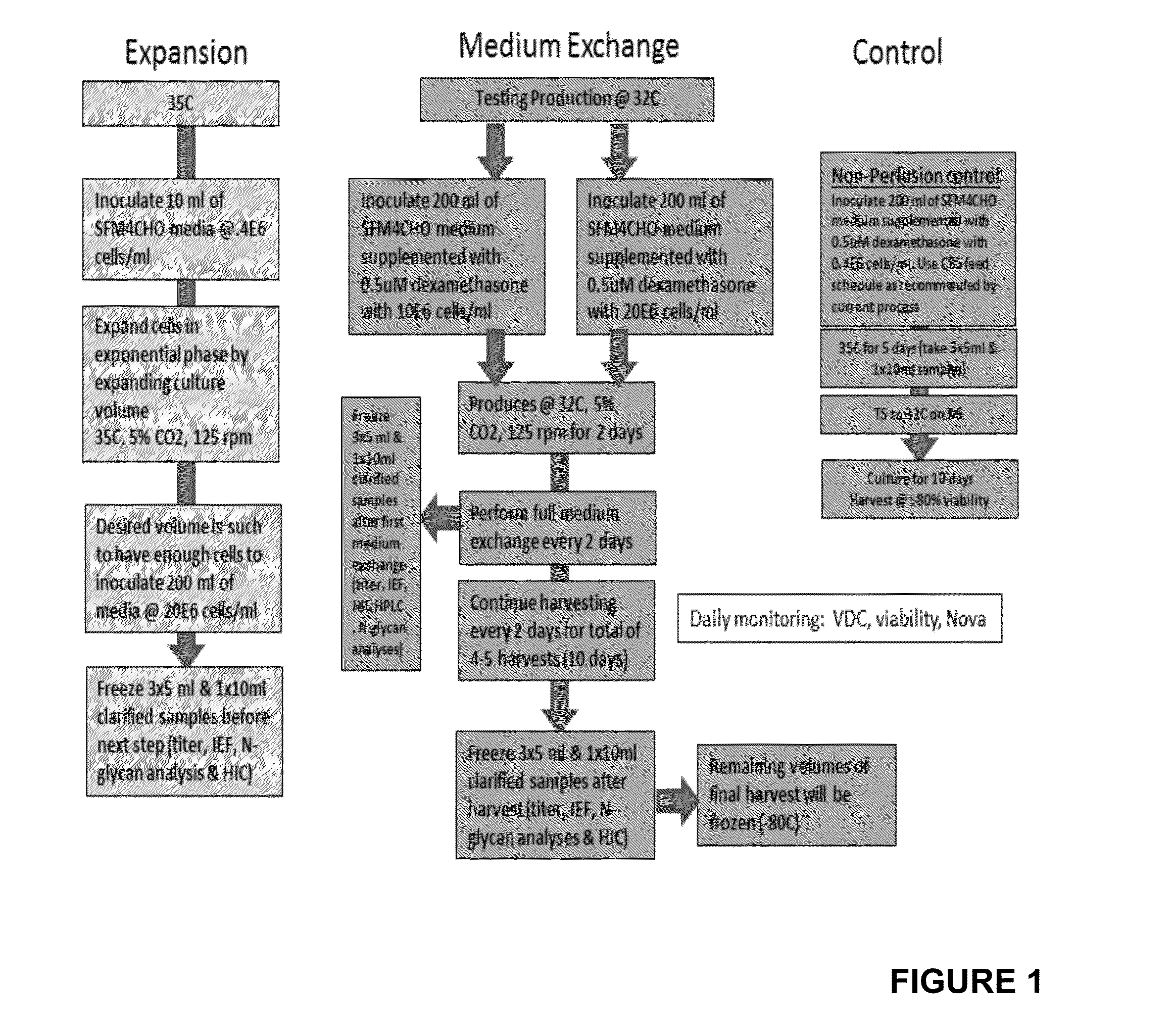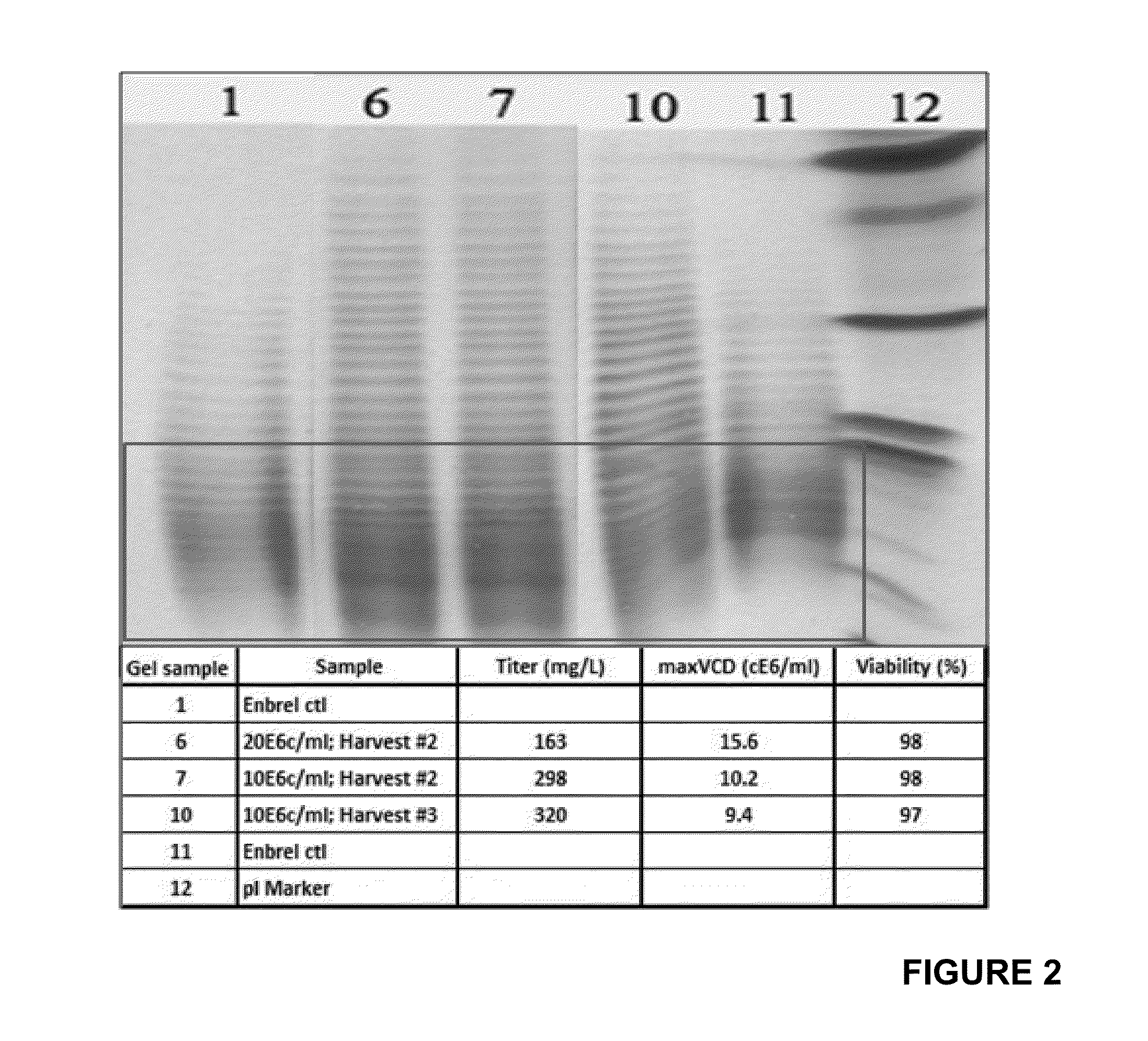Protein Production Method
a technology of protein and production method, which is applied in the direction of fused cells, drug compositions, immunological disorders, etc., can solve the problems of large amount of incorrect or misfolded products produced by cho cells, significant reduction of yields, and detrimental to patients, and achieve excellent yields
- Summary
- Abstract
- Description
- Claims
- Application Information
AI Technical Summary
Benefits of technology
Problems solved by technology
Method used
Image
Examples
example 1
Media Formulation
[0055]
Feed ComponentConcentrationSFM4CHO1xCell Boost 520%Dexamethasone0.5 uM
[0056]Each culture, maintained in temperatures ranging from 32° C. to 35.5° C., was allowed to produce Etanercept protein for two days before medium was fully exchanged for a subsequent round of production. These 2-day harvest intervals are comparable to a perfusion rate of 0.5 bioreactor volume per day. The medium exchange is repeated 4 times (4 cycles). Harvested media is frozen at −80° C. Titers are analyzed by ForteBio and TNF-binding ELISA. Additionally each sample is assessed for N-linked glycoprofile, protein charge distribution by IEF gel and for protein folding by hydrophobic interaction chromatography (HIC).
[0057]In order to support the high cell numbers necessary for inoculation of high density production cultures typically achieved in a perfusion process, the seed train is conducted in large volume shake flasks maintained at 35° C. or 37° C., 5% CO2 level and the speed of the orb...
example 2
[0058]In order to support the high cell numbers necessary for inoculation of high density production cultures characteristic of perfusion processes, the seed train is conducted in large volume shake flasks maintained at 35° C. or 37° C., 5% CO2 level and the speed of the orbital shaker is adjusted to 125 rpm. Production phase shake flasks containing SFM4CHO medium supplemented with Cell Boost 5 feed and 0.5 uM dexamethasone are inoculated at cell densities either 5 million cells per milliliter or 8 million cells per milliliter. The following media formulation was used.
[0059]Example 2 Media Formulation
Feed ComponentConcentrationSFM4CHO1xCell Boost 520%Dexamethasone0.5 uM
[0060]The production phase is conducted at temperatures 33.5° C. or 35.5° C., otherwise all other culture conditions are the same. Cultures are monitored daily for viable cells densities and viabilities. To achieve the equivalent of a perfusion rate of 0.5 bioreactor volume per day the medium in each culture is fully ...
example 3
Media Formulation
[0062]
Feed ComponentConcentrationSFM4CHO1xCell Boost 520%Dexamethasone0.5 uM
[0063]An ATF™ cell retention device (Refine Technology) is used to recirculate medium (containing waste products and desired product) past a hollow fiber filter, with recirculation rates from 0.1 to 2.0 working culture volumes per minute. The culture is expanded for 0 to 2 days, and then perfusion is initiated at rates from 0.2 to 2 culture volumes per day. New medium is added as spent medium, containing the product, is harvested through a 0.2 um pore size hollow fiber filter. Harvested fluid is chilled to 2-8° C., purified by capture on protein A resin. Aliquots are analyzed for titer and N-glycan distribution, as described for Examples 1 and 2. HIC analysis may be used to evaluate the relative amounts of properly folded etanercept, versus improperly folded / aggregated (inactive) material.
[0064]FIG. 14 shows the VCD, which reached around 12×106 cells / mL during the perfusion production phase....
PUM
| Property | Measurement | Unit |
|---|---|---|
| Temperature | aaaaa | aaaaa |
| Temperature | aaaaa | aaaaa |
| Temperature | aaaaa | aaaaa |
Abstract
Description
Claims
Application Information
 Login to View More
Login to View More - R&D
- Intellectual Property
- Life Sciences
- Materials
- Tech Scout
- Unparalleled Data Quality
- Higher Quality Content
- 60% Fewer Hallucinations
Browse by: Latest US Patents, China's latest patents, Technical Efficacy Thesaurus, Application Domain, Technology Topic, Popular Technical Reports.
© 2025 PatSnap. All rights reserved.Legal|Privacy policy|Modern Slavery Act Transparency Statement|Sitemap|About US| Contact US: help@patsnap.com



